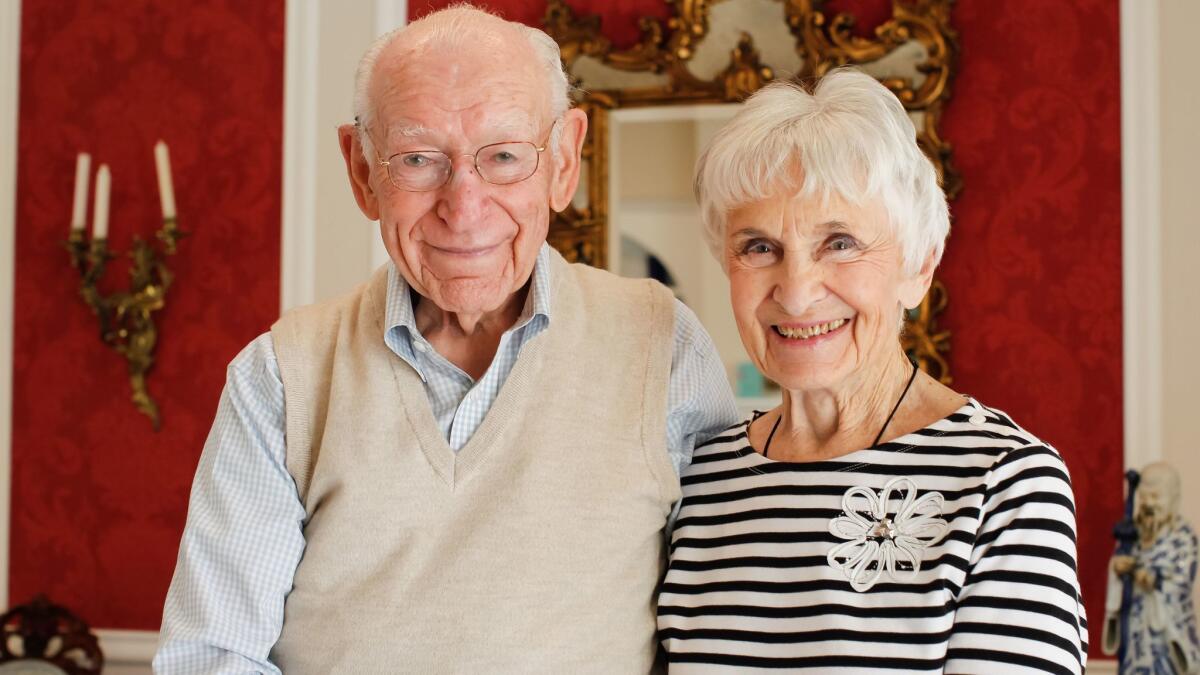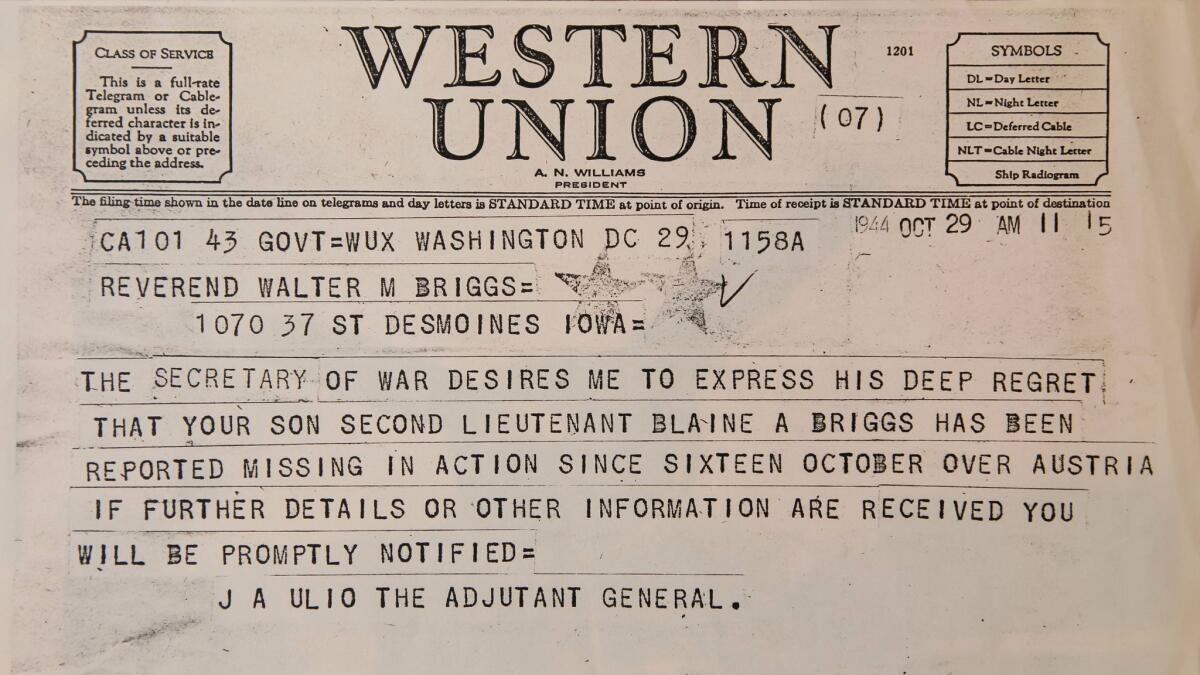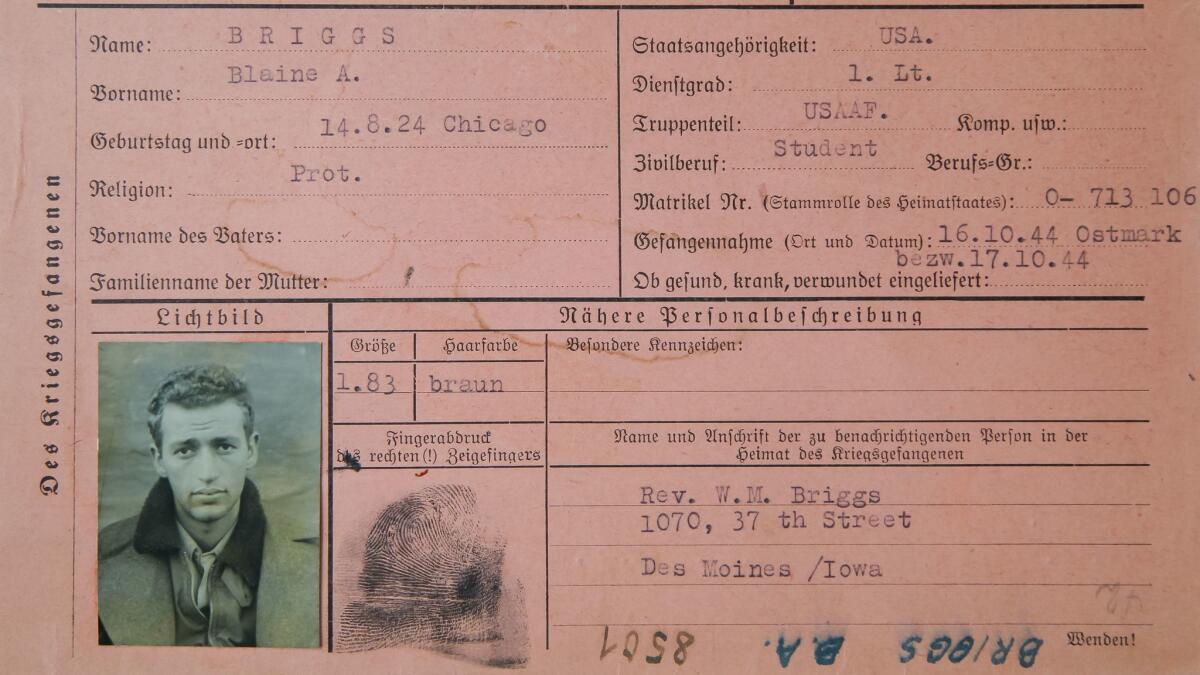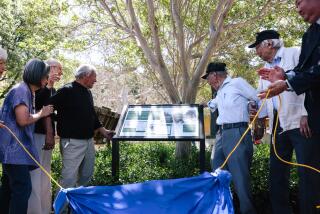WWII veteran, POW was shaped by war
- Share via
Carlsbad — Seventy-three years ago, Blaine Briggs parachuted from a burning B-24 bomber, broke his shoulder in a hard landing in the Italian Alps, was nearly shot to death by his German captor and then spent more than six months starving half to death in a prison camp.
Yet for all the hardship he endured and the millions of lives lost during the years-long conflict, the 92-year-old Briggs said he believes the war experience shaped him into the man he became. His time in the military and the camaraderie of the prisoners in the camp taught him lessons in courage, self-reliance, teamwork and trust. In short, he calls it the greatest educational experience of his life.
“Every person should have the same opportunity I had to train and work and help my fellow man. I wouldn’t trade it,” he said.

Now retired with his wife of 70 years, LaVerne, Briggs lives in a hilltop home inside the La Costa Glen retirement community in Carlsbad.
Two years ago, the couple was honored by The Patriots Initiative with the inaugural Lifetime Patriot Award. The award honored both his service in the military and the couple’s lifetime of philanthropic service to military veterans and others.
Born in 1924, Briggs was the son of a Methodist minister who moved from congregation to congregation, so his family lived in a number of Midwestern towns before settling in Des Moines, Iowa, when he was 16.
On Dec. 7, 1941, he and his family were enjoying lunch at home after Sunday morning services when news of the Pearl Harbor attack came on the radio. He couldn’t wait to join the Army, but at 17 was too young to apply. Eight months later, on his 18th birthday, he enlisted.
His two older brothers also signed up, one joined the Marines and became a correspondent in China, the other served in the Navy on a battleship. All three returned home safely.

Because Briggs was a college student when he signed up, he was eligible for officer’s school. After two years of training in Texas as a navigator for the Army Air Corps, 2nd Lt. Briggs and his B-24 crew shipped out on June, 3, 1944, to join the 451st Bombardment Group in Europe. Together, they flew 26 successful bombing missions over Germany, but their 27th mission was star-crossed from the start.
On Oct. 16, 1944, their plane was assigned to lead the 15th Air Force on a bombing raid but their plane wasn’t cooperating. After they took off, the plane’s nose wheel wouldn’t retract and the bomb bay doors didn’t open properly.
German ground guns shot out one engine, but they were able to manually open the bomb doors and drop their payload before a second barrage of gunfire took out their second engine and set the plane on fire in the foothills of the Italian Alps.
“When the captain gave the order to abandon the plane, we were happy to do it,” he said. “My main thoughts at the moment was to get the hell out of that plane.”
The navigator’s seat was at the front of the plane below the cockpit, just a few feet from where the broken nose wheel’s bay was wide open, so Briggs dropped through the hole at an altitude of 11,000 feet and fell like a stone with the orders to open his chute as close to the ground as possible to avoid detection by German search crews. He pulled the cord at 2,000 feet and broke his shoulder when he hit the ground.
Over the next two days, he made his way alone down the mountain in the hopes of escaping into Italy. He came upon a German village where two homes had Christian crèches in their front yard.
As a minister’s son, he considered asking the families for sanctuary but worried that the villagers would pay too steep a price from their government for showing mercy, so he moved on.
Eventually he was caught by a German officer and private on foot patrol. The private put a gun to Briggs’ forehead and prepared to shoot, but the officer stopped him. During two interrogations by Gestapo officers, Briggs learned that 10 of his fellow B-24 crew members survived. The flight engineer, whose hands became frozen while trying to save the plane, is believed to have died in the crash.

The men were taken to Germany’s Stalag 3 prison camp just four months after an infamous mass escape of more than 50 British POWs that was later chronicled in the book “The Great Escape.”
Most of those escapees were shot dead, but Briggs said he and the American officers he was imprisoned with were treated well. In fact, at a reunion some 20 years after the war, the prisoners invited their German guard to join them because they thought he treated them fairly.
By November it was obvious Germany was losing the war. The Russians were closing in from the east, so the prisoners were marched 100 miles to another camp near Munich.
Food was so scarce, the prisoners survived on bread made with sawdust and watery stew with little meat. Briggs dropped 40 pounds before the camp was liberated by U.S. troops in May 1945. He and a buddy walked to an abandoned Germany air base and stole a Jeep that they drove to Frankfurt and caught a transport plane to Paris on the very day the city’s electricity was restored.
“That was the night the lights came back on in Paris,” Briggs said. “I’ve never kissed so many girls in one night in my life.”
Briggs returned to the U.S. on a freight ship that dropped its gangplank on June 3, 1945, exactly one year to the day since he left for Europe. He was greeted with a hero’s welcome in Des Moines and returned to his political science studies at Drake University, where he soon met LaVerne at a local roadhouse.
“This beautiful woman came in and she was carrying a fifth of whiskey,” he said. “I went over and talked to her and fell in love in 30 minutes. When I got back to my table I told my friends ‘that’s the girl I’m going to marry.’ ”

And they did, a year later, and had two sons. Their youngest, Jim, died at age 16 from leukemia but their oldest son, Bob, now 66, is a Memphis pilot who once set a Guinness World Record for being certified to fly 104 different aircraft.
After the war, the Briggses ran a suburban newspaper for a few years, then a large printing operation until the 1960s, where all of their male employees were veterans or active servicemen. Later they ran one of the nation’s largest medical records businesses. They retired to Rancho Santa Fe in 1980 and moved into La Costa Glen nine years ago.
Since retiring, the Briggses have underwritten a rehabilitation clinic at Scripps Memorial Hospital Encinitas, served on several charitable foundations and support La Costa Glen’s “boxes overseas” program for deployed military. It was these efforts that earned them the Lifetime Patriot Award.
Briggs said his war experiences positively shaped the man that he would later become and he owes a great debt to his country. He said the America he returned to in June 1945 was far different from today’s troubled world, which makes him especially appreciative of his time in uniform.
“We’re not very political but we do have great concern for where the world may be going in the next 20 years,” he said. “We’re blessed that we spent our lives the way we did.”
pam.kragen@sduniontribune.com



